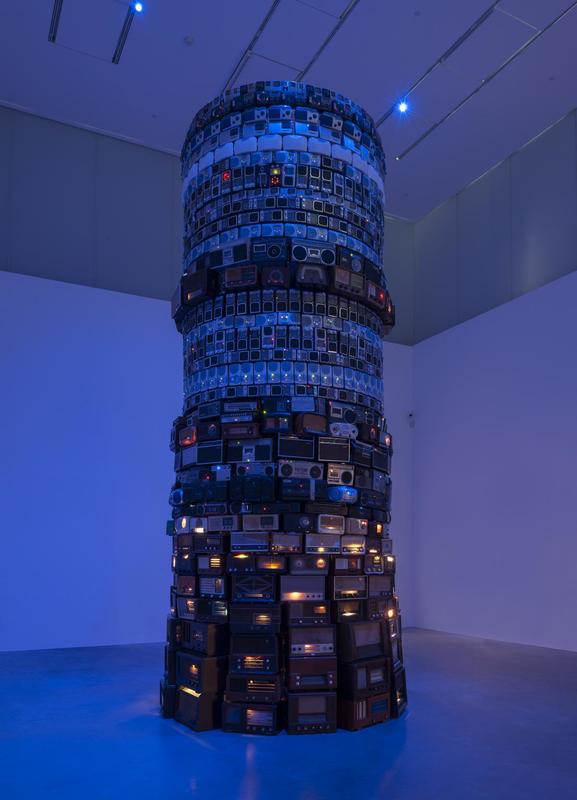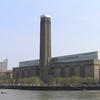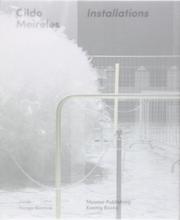More about Babel
- All
- Info
- Shop

Contributor
Cildo Meireles’ Babel is both very cool and also a reference to the biblical story of the Tower of Babel.
The story of the Tower of Babel is as follows. Humans were all one big happy fam and as such decided to build a tower that would reach the heavens so that they could chill with God. God thought this an abhorrent invasion of privacy and in the midst of the construction made it so that all of the people spoke different languages, making construction pretty much impossible. And just to put a final nail in the coffin of the whole heavenly tower idea, God swept people across the earth, which is why humans live all over the globe and speak all different languages. This is also why we have things like xenophobia and war. So good going, God. Geez!
The Tower of Babel is a really popular subject for artists. Lucas van Valckenborch, the Flemish painter has one, Hendrick van Cleve has one, Pieter Brueghel the Elder has two Tower(s) of Babel. There is even an artist by the name of Svetlana Petrova, known for photoshopping her cat’s face into different famous works of art in a book called "Fat Cat Art: Famous Masterpieces Improved by a Ginger Cat with Attitude," who has one.
But none (not even the cat) rival that of Cildo Meireles, because his is not just a painting, but an actual 3D tower installed in the Tate Modern. It’s height varies based on who installs it but it’s very tall and made out of old school analog radios. These radios are all on and turned to the lowest volume so no individual radio has decipherable language. The effect is this really off-putting white noise. The tower is also in a room of its own and bathed in blue light which steeps the whole installation in this trippy light, givit it a very eerie vibe. This whole structure took the artist ten years to complete, but it’s definitely worth the trip to London. If God had just let us all hang out together, you might not have had to fly there, but whatever.
Sources
- Barson, Tanya. "‘Babel’, Cildo Meireles, 2001 | Tate." Tate. N.p., 2011. Web. 5 Oct. 2018. https://www.tate.org.uk/art/artworks/meireles-babel-t14041
- Cildo Meireles – A Tower That Could Reach The Heavens | Fresh Perspectives. London: Tate, 2016. Video. https://www.youtube.com/watch?v=446zJBtYz10
- Stanska, Zuzanna. "Most Famous Babel Towers In Art - Dailyartmagazine.Com - Art History Stories." DailyArtMagazine.com - Art History Stories. N.p., 2017. Web. 5 Oct. 2018. http://www.dailyartmagazine.com/famous-babel-towers-art/

Contributor
Meireles' majestic Babel deploys what Tariq Harris calls "perspectival foreshortening," a trick of the eye caused by the artist's decision to put big, clunky radios at the bottom of the tower.
The physical and visual weight of the clunkers at the bottom and the newer, slimmer models at the top of the pile make it appear as if the tower is taller than it actually is, because the upper radios recede from our view. This structure is five meters, or 197 inches, in height. The assemblage consists of more than eight hundred different radios from different eras, tuned to a variety of channels. Noticing the wide range of radios for sale on Canal St. in New York, Meireles began this work, finishing it eleven years later in Helsinki. Meireles and his team built Babel on-site around a hollow column of interlaced wire supported by metal beams. The unbroken symphonic cacophony, the babbling of hundreds of frequencies, represents the Divine punishment, in the Biblical source, for those who make great technological works without yiras shamayim, or "fear of heaven." "No soup for you!" came the Divine response to those who built the tower, forgetting who saved them from the Flood. And that's why we have different languages, crosstalk, miscommunication, cultural beefs, and all the associated problems and joys.
In her excellent discussion of the original source in the written Torah, Dr. Shira Weiss tells us that the sin of the tower of Babel is a sort of political sequel to the sin of Adam and Chava (Eve). Whereas Adam and Chava had a perfectly good etz ha-chayyim (tree of life) to eat from, they chose to eat from the etz ha-daas, the tree of knowledge, and the Divine Being had to evict them from the garden in order to prevent them from gaining immortality with their increased knowledge. They didn't even get a 30-day notice. The tower is similar, says Weiss, in that it is a continuation of the work and arrogance of Enosh, the grandson of Adam and Chava, who initiated the worship of planets and stars, and would have been one of the first career astrologers. Nimrod, grandson of Noah, recognized that Enosh was on to something, and, being a great hunter, told everyone else to worship him, like tyrants and dictators later would. In an effort to please Nimrod, people baked bricks in clay ovens, an arduous undertaking, to build a tower reaching the heavens. According to oral tradition, they didn't mind if a person fell from the tower, but if a brick fell, they became despondent. Meanwhile, nearby, Avraham, the first monotheist, was cursing the builders of the tower, and they cursed him right back, saying, "He's sexually infertile because his Almighty isn't real. Let's build a person with a sword at the top of the tower to defeat his deity."
Sources
- Brett, Guy. Cildo Meireles, ex. cat. London: Tate Modern, 2008.
- Broughton, Luke Dennis. The Elements of Astrology. New York: Ray Broughton, 1906.
- Etheridge, John Wesley. The Targums of Onkelos and Jonathan Ben Uzziel on the Pentateuch: With the Fragments of the Jerusalem Targum: from the Chaldee, Volume 2. London: Longman & Company, 1862.
- Grovier, Kelly. Art Since 1989. London: Thames & Hudson, 2015.
- Harris, Tariq. "Cildo Meireles — A Tower that could Reach the Heavens." YouTube Video, 2:03, Dec. 18, 2016, https://youtu.be/446zJBtYz10.
- Pakarinen, Hannu. "Making of Babel by Cildo Meireles." YouTube Video, 3:30, Nov. 27, 2012, https://youtu.be/QmpkMMFCPv8.
- Weiss, Dr. Shira. "Migdal Bavel: How do we define Avoda Zara?" YUOnline, Jul. 12, 2011, https://www.yutorah.org/lectures/lecture.cfm/762626/dr-shira-weiss/migd….












